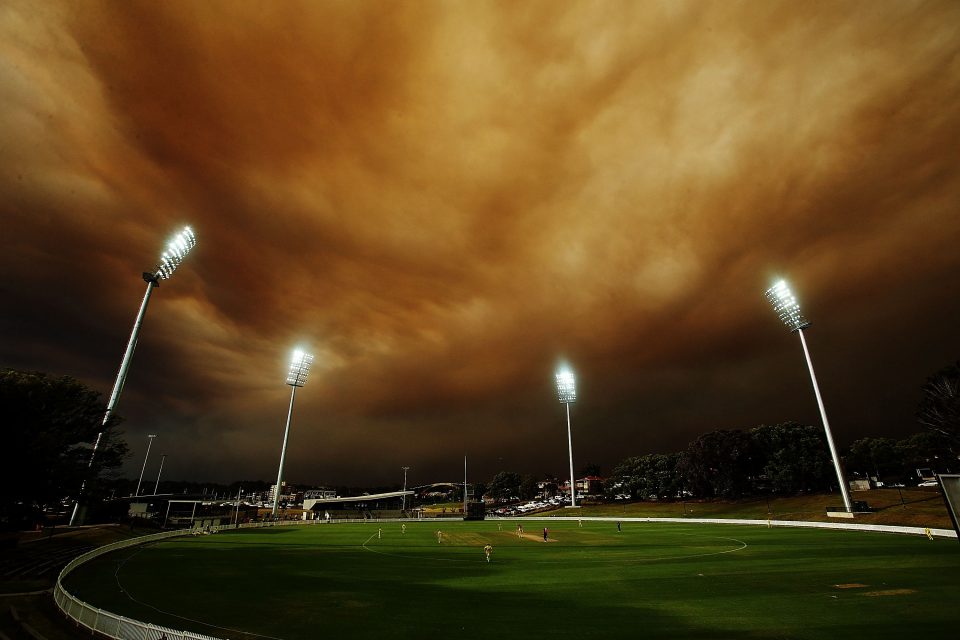Part one | Sport and the climate crisis
Sport gives fans an escape from reality, but it cannot escape the reality of climate change. Not least, cyclones and water shortages threaten grounds and tournaments.
Author:
22 February 2021

Before drought descended on the Western Cape in 2015, Evan Flint was precipitous with his use of water. As the head groundskeeper at Newlands Cricket Ground in Cape Town, it was his job to keep the outfield lush and provide South Africa’s seam bowlers with enough grass on the wicket to prise out opposition batters.
“Sometimes I’d water the pitch twice a day, just because I could,” Flint says. “It wasn’t until I was forced to change that I had my eyes opened.”
By early 2016, the city’s dams had dropped below 50% capacity. By 2017, residents were prohibited from watering their gardens or running baths. When India’s cricket team arrived for a Test match in January 2018, the city was gripped by fear that the prophesied Day Zero would dawn and taps would run dry.
Lifesaving rain that winter prevented total disaster, but the terror Flint felt has stayed with him. Though he now works as the Wanderers’ head groundskeeper in the more water secure city of Johannesburg, his experience has left an indelible mark.
Related article:
“It was incredibly scary on a personal level,” Flint recalls. “Professionally it was a challenge. The outfield did deteriorate but it was like a badge of honour. More importantly it taught me that you only need to water the pitch twice a week. I’d encourage all groundsmen to be water wise. But I can’t get on a high horse and lecture people. It took me living through that experience before I woke up. Unless it’s right in front of you, you don’t think about it. We got lucky. Others in the future might not be.”
This is a microcosm of sport’s collision with the climate emergency. A report published in June last year by the Rapid Transition Alliance and authored by journalist and academic David Goldblatt paints a bleak future for the games we play.
Unless drastic action is taken, coastal golf courses, including St Andrews in Scotland, will one day crumble into the advancing sea. Cricket played at famous stadiums such as Eden Gardens and the Melbourne Cricket Ground will be strictly nighttime affairs as a result of unbearable heat during the day. Skiing and bobsleigh will be unfeasible without sufficient snowfall at venues that once hosted the Winter Olympics. Football and rugby fields in low-lying areas like the Netherlands, the United Kingdom and the Pacific Islands will be partially or completely submerged. Elsewhere, forest fires and pollution will render the air unfit for athletic competition.
“The stadium is on fire,” Goldblatt says from his home in Bristol, paraphrasing climate activist Greta Thunberg’s address to world leaders at the World Economic Forum in Davos in 2019. “But I remain hopeful. To quote the Italian Marxist and anti-fascist Antonio Gramsci, I have the pessimism of the intellect, the optimism of the will. The outlook isn’t great. But we’re not without hope.”
According to the Paris Climate Agreement, we have until 2050 to achieve carbon neutrality and prevent a rise of 1.5°C across the planet. Failure to do so would result in an increase in floods, hurricanes, wildfires and droughts, as well as millions of people displaced from their homes. The Intergovernmental Panel on Climate Change says our deadline for achieving these goals is 2030. The clock is ticking.
Sport’s crimes
Global sport is not wholly blind to this crisis. The United Nations Environment Programme and the International Olympic Committee (IOC) came together in 1999 to write environmental sustainability principles into the Olympic charter. But the IOC’s power to influence action proved ineffective once a bid was accepted. Trees in national parks and ancient forests were felled in Russia and South Korea to stage Winter Games events. Pollution in Beijing increased once the 2008 Summer Games had concluded. Degradation and damage to the environment was also apparent in Athens, Vancouver, London and Rio.
At the UN Climate Change Conference in December 2018, the Sports for Climate Action Framework was launched to “gather sports organisations, teams, athletes and fans in a concerted effort to raise awareness and action to meet the goals of the Paris Agreement”. Early signatories included Fifa, Uefa, the IOC and the Summer Olympic committees of Tokyo 2020 and Paris 2024.
More have joined since – such as World Rugby and Formula 1 – but there are still noticeable absentees. Even though cricket and golf are two sports at the mercy of unstable weather patterns, the International Cricket Council and golf governing body the R&A have so far refrained.
Related article:
“Communication is a major barrier,” says Dom Goggins, a consultant in environmental policy who co-authored the 2018 Game Changer report that investigated how climate change is affecting sport in the UK. In the document, the warming planet is positioned as an opponent that needs beating rather than a catastrophe waiting to happen.
“We wanted to appeal to the competitive spirit that sport encourages,” Goggins explains. “It’s important not to wag a finger in anyone’s face or pass any judgement. That is not how you increase commitment. This is still a polarising debate and people tune out either because it’s terrifying or because they’re facing more immediate issues. For many people, the climate emergency is tomorrow’s problem.”
This is why athletes are crucial. By raising their fist and taking a knee, sportspeople across the world have served as catalysts for conversations about racial inequality and social justice. Campaigning by the Atlanta Dream basketball team played a key role in the United States presidential and Georgia Senate elections. And with both results going in favour of the Democratic Party, Joe Biden re-entered the US into the Paris Accord and kept climate change denialist Donald Trump out of power.
Related article:
Some athletes have used their fame to call for action on environmental policy. Stars like Lewis Hamilton, Serena Williams and Rory McIlroy have appealed to their sports to act on this emergency, but most professionals are understandably primarily occupied with their performance.
Retired Australian rugby player David Pocock is a notable exception in that he risked his career during the height of his power to take a stand on protecting the planet. He was arrested for chaining himself to a digger during a coal mining protest in 2014.
Speaking on eight-part podcast series Emergency on Planet Sport, Pocock said: “I was told [by Rugby Australia], ‘If you do anything like this again, we’ll tear up your contract.’ Athletes speaking out about issues really does lead to important conversations among young people, and who knows where that can lead. Many have dreamed of what they’ve been doing since they were kids and I think there’s a fear these other issues will somehow detract from their sport or take their concentration away or open them up to criticism.”
Pocock stressed that his activism helped motivate him on the field. LeBron James continues to dominate games for the Los Angeles Lakers while positioning himself as a leading voice in the Black Lives Matter movement. Similarly, Marcus Rashford’s drive to feed hungry children in the UK has not hampered his contributions in front of goal for Manchester United.
The contribution of sponsors
Rapid Transition Alliance co-ordinator Andrew Simms recently told The Guardian newspaper: “Sport provides some of society’s most influential role models. If sport can change how it operates to act at the speed and scale necessary to halt the climate emergency, others will follow.”
However, the tail can’t wag the dog. Athletes and fans can make as much noise as they like but change must come from governing bodies and teams. As Goldblatt points out, sport is not a victim of a warming planet but a major contributor: “If the sports world is to make its own contribution to climate change action, then it needs to acknowledge its own role in creating the problem and radically reduce its carbon footprint, and thus it needs to know how much carbon it is actually producing.”

Accounting for air travel by fans, athletes, coaching staff and broadcasters, the construction of stadiums and the global sportswear industry, Goldblatt estimates that the entire sports circuit contributes approximately 30 million tonnes of carbon emissions every year. This is equivalent to the output of either Denmark, Tunisia or New Zealand.
Then there is sport’s reliance on money from airlines, petrochemical companies and vehicle manufacturers. Arsenal and Manchester City are two Premier League clubs lauded for their green innovations that save energy and water but are sponsored by aviation companies. Fifa and Uefa, two standout voices in the Sports for Climate Action Framework, cash cheques from Russian energy corporation Gazprom.
Before Formula 1 banned tobacco advertising on cars and uniforms, critics wondered how the sport would survive without this revenue stream. But these concerns were soon put to rest. Formula 1 made more than $2 billion in 2019.
Related article:
Smaller organisations can thrive without depending on planet-destroying corporations. Forest Green Rovers Football Club in England’s fourth tier is a shining example. They are the first UN-certified carbon-neutral football club and use 100% renewable energy. All food served at the ground is vegan, the lawnmower that tends to the pesticide-free pitch is fully electric, and plans have been approved for a carbon-neutral wooden stadium.
“It will be the greenest stadium in the world since the Romans invented concrete,” club owner Dale Vince, who made his fortune in wind power, said last year. The buzz around the small club in rural Gloucestershire has attracted global attention.
Global warming’s effect on sport
While the battle for hearts and minds rages, the consequences of mass inaction continue. The past six years are all among the six hottest ever recorded. In that time, enough warning bells, too many to list in full here, have been sounded.
As recently as 2019, Typhoon Hagibis battered the Rugby World Cup while scorching temperatures meant in-game water breaks were needed during the Women’s Fifa World Cup in France. In Egypt, at the 2019 Africa Cup of Nations, Samuel Kalu collapsed at training owing to severe dehydration from the boiling heat in Cairo. In January 2020, the Australian Open tennis tournament was disrupted by smoke from devastating bushfires blowing into Melbourne as players struggled to breathe.
It will only get worse. Coastlines will disappear. Fields will become swamps. Snowcaps will melt and never return. Rivers will run dry. This is the single greatest threat we as a species have faced. Sport may represent a means of escape from the mundanity and hardships of life, but it cannot exist in the world scientists are warning will take shape.
“What’s worse is that the Global South will bear the brunt of this the most,” Goldblatt warns.
Related article:
Bangladesh, the third-most populous major cricket-playing nation, is projected to experience mass flooding and the forced exodus of large swathes of its population in the coming decades. The same fate is in store for the islands of Fiji, Tonga and Samoa, whose rugby players account for roughly 20% of professional players worldwide, according to lobby group Pacific Rugby Players Welfare. While wealthy nations will have the resources to mitigate rising temperatures with air-conditioned stadiums, more impoverished regions will be unable to stage athletic events.
Even though the situation is dire, a calm and measured response is still required. “I’ve done a lot of blood boiling and have made a conscious decision not to do that anymore,” Goldblatt says. “Boiling blood is not going to help. If anything, it will make it harder to have conversations with people who don’t want to engage. This movement needs very different voices. The time for anger has passed. We need action now.”

There are scores of fan groups and independent organisations that use sport as a vehicle to drive this dialogue. Protect Our Winters seeks to raise awareness on the effects of melting ice caps. Frontrunners encourages Australia’s sports stars to use their platforms to espouse change. Champions for Earth empowers athletes to use their popularity to spread their message. Planet Super League focuses primarily on football and the sport’s role in this cause.
All require funding and followers. Reports like those by Goldblatt and Goggins require reading and sharing. We may be in injury time, but the clock is still ticking. If sport has taught us to believe in anything, it is the enduring power and magic of the comeback. That hope remains as long as there is a will to continue the fight. We can no longer afford to be mere spectators. Along with everything else on this planet, the games we love are at stake.
This is the first of a two-part series looking at sport and climate change. The second part looks at what sport needs to do to contribute positively to this fight.






